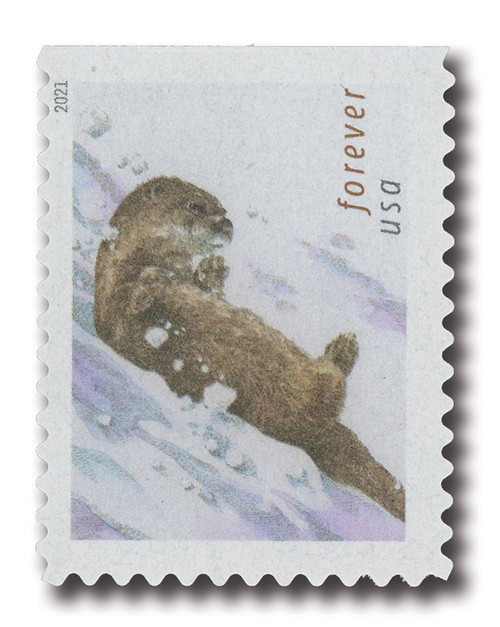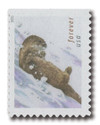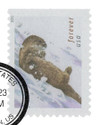
# 5649 - 2021 First-Class Forever Stamps - Otters in Snow: Otter, Tail at Right
US #5649
2021 Otter, Tail at Right – Otters in the Snow
- One of four stamps picturing otters playing in the snow
Stamp Category: Definitive
Set: Otters in the Snow
Value: 58¢ First Class Mail Rate (Forever)
First Day of Issue: October 12, 2021
First Day City: Otter, Montana
Quantity Issued: 300,000,000
Printed by: Banknote Corporation of America
Printing Method: Offset
Format: Double-sided Booklets of 20
Tagging: Phosphor Tagged Paper, Block Tag
Why the stamp was issued: To showcase playful otters in their natural winter habitat.
About the stamp design: Pictures a pen, ink, and watercolor illustration of an otter sliding on its back in the snow. Artwork by illustrator John Burgoyne, whose work has been pictured on other US stamps in the past.
First Day City: The First Day of Issue city was Otter, Montana, but no official First Day Ceremony was held.
About the Otters in the Snow set: In 2021, the USPS created a set of four Forever stamps picturing otters’ wintertime behaviors. Each features original pen, ink, and watercolor illustrations by artist John Burgoyne. The stamps reflect the playful nature that has made otters so popular with the public.
History the stamp represents: The Eurasian otter (Lutra lutra) is the most widely found otter species in the world. It lives in waterways across Europe and Asia, as well as northern Africa. The Eurasian otter’s adaptability allows it to survive in a variety of climates.
Eurasian otters can live in just about any unpolluted body of water. This may include lakes, rivers, canals, and even ponds. Otters may be seen in and around salt water, but they are a freshwater species and should not be confused with their larger sea otter cousins.
Eurasian otters primarily eat fish. Individuals that live in warmer climates, such as the Mediterranean, feed on fish year-round. However, those that live in regions with defined seasons change their eating habits as fish becomes less readily available. During winter months, Eurasian otters still eat some fish, but mainly subsist on crustaceans, insects, amphibians, and occasionally small mammals.
Eurasian otters are extremely territorial animals, and spend most of their lives on their own. A single otter’s territory can be up to 25 miles long, but most are around 10 miles. The size depends on the availability of food and water. Males and females may have territories that overlap as there is no defined mating season.
Eurasian otters were once in decline, but their numbers have begun to recover across their range.
US #5649
2021 Otter, Tail at Right – Otters in the Snow
- One of four stamps picturing otters playing in the snow
Stamp Category: Definitive
Set: Otters in the Snow
Value: 58¢ First Class Mail Rate (Forever)
First Day of Issue: October 12, 2021
First Day City: Otter, Montana
Quantity Issued: 300,000,000
Printed by: Banknote Corporation of America
Printing Method: Offset
Format: Double-sided Booklets of 20
Tagging: Phosphor Tagged Paper, Block Tag
Why the stamp was issued: To showcase playful otters in their natural winter habitat.
About the stamp design: Pictures a pen, ink, and watercolor illustration of an otter sliding on its back in the snow. Artwork by illustrator John Burgoyne, whose work has been pictured on other US stamps in the past.
First Day City: The First Day of Issue city was Otter, Montana, but no official First Day Ceremony was held.
About the Otters in the Snow set: In 2021, the USPS created a set of four Forever stamps picturing otters’ wintertime behaviors. Each features original pen, ink, and watercolor illustrations by artist John Burgoyne. The stamps reflect the playful nature that has made otters so popular with the public.
History the stamp represents: The Eurasian otter (Lutra lutra) is the most widely found otter species in the world. It lives in waterways across Europe and Asia, as well as northern Africa. The Eurasian otter’s adaptability allows it to survive in a variety of climates.
Eurasian otters can live in just about any unpolluted body of water. This may include lakes, rivers, canals, and even ponds. Otters may be seen in and around salt water, but they are a freshwater species and should not be confused with their larger sea otter cousins.
Eurasian otters primarily eat fish. Individuals that live in warmer climates, such as the Mediterranean, feed on fish year-round. However, those that live in regions with defined seasons change their eating habits as fish becomes less readily available. During winter months, Eurasian otters still eat some fish, but mainly subsist on crustaceans, insects, amphibians, and occasionally small mammals.
Eurasian otters are extremely territorial animals, and spend most of their lives on their own. A single otter’s territory can be up to 25 miles long, but most are around 10 miles. The size depends on the availability of food and water. Males and females may have territories that overlap as there is no defined mating season.
Eurasian otters were once in decline, but their numbers have begun to recover across their range.







